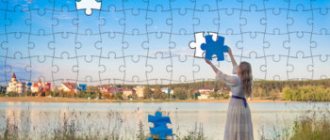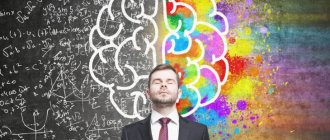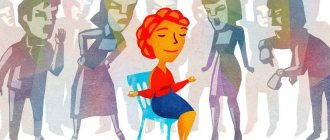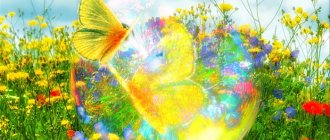Imagination is the process of creating images of objects and phenomena that have never been perceived by a person before.
Imagination is a necessary element of creative activity, expressed in the construction of an image of the final and intermediate products of labor, and also ensures the creation of a program of behavior in cases where the problem situation is characterized by uncertainty. Those. imagination allows you to imagine the result of work before it begins, to imagine not only the final product, but also intermediate results.
Imagination is closely related to thinking. Just like thinking, imagination arises in a problem situation, i.e. when you need to find a new solution. But the advanced reflection of reality in the process of imagination occurs in the form of vivid ideas, and the advanced reflection in the process of thinking occurs by operating with concepts. If the initial data of a problem are known, then the course of its solution is subject primarily to the laws of thinking (for example, a scientific problem).
If the problem situation is characterized by uncertainty and the initial data is difficult to accurately analyze, then mainly the mechanisms of imagination come into play (for example, the work of a writer). Fantasy allows you to “jump” over some stages of thinking, when the necessary completeness of knowledge is missing, and still imagine the end result. Although sometimes the solutions outlined by imagination are not accurate enough.
Imagination is closely related to perception and memory, because... imagination is always built on processed material from past perceptions that a person has remembered. For example, when creating an image of a desert, a person relies on past experience (he knows what sand is, he saw a camel in a picture or in a zoo).
Processes of creating images of the imagination.
The technology for creating imaginative images is of an analytical-synthetic nature, i.e. carried out using analysis and synthesis. A person dismembers a previously established system of ideas and creates new images on this basis. Even if you come up with something completely extraordinary, then upon careful examination it will turn out that all the elements from which the fiction was formed are taken from life, are the results of an intentional or unintentional analysis of countless facts.
But analysis and synthesis when creating images of the imagination can be carried out in various forms.
1. Agglutination (translated from Greek as gluing) is a combination of various qualities, properties, parts characteristic of two different objects. Many fairy-tale images are constructed through agglutination (mermaid, hut on chicken legs, centaur). This technique is also used in technical creativity (an amphibious tank combines the qualities of a tank and a boat, an accordion combines a piano and button accordion, a trolleybus).
2. Hyperbolization (hyperbole - increase an object, lithol - decrease) - an increase or decrease in objects, or a change in the number of parts of an object (a giant, Thumb, many-armed goddesses in India, a dragon with seven heads, a one-eyed Cyclops).
3. Emphasis – sharpening of any features (friendly cartoons or evil caricatures).
4. In the event that the ideas from which the image of fantasy is constructed merge, the differences are smoothed out, and similarities come to the fore, this contributes to the implementation of schematization (the artist’s creation of a national ornament, the elements of which are taken from the plant world; the image of an Italian, an American and etc.).
5. Typification – used in fiction, sculpture, painting; What is characteristic here is the identification of the essential, repeated in homogeneous facts, and the embodiment of this in a specific image.
Types of imagination
Based on the degree of activity in the process of creating new images, two types of imagination are distinguished: active and passive.
Active imagination arises from human needs and stimulates his creative and practical activity. An active imagination can be creative and reconstructive.
Recreating is the recreation of images of existing objects, the creation of images that correspond to the description.
Creative is the independent creation of new, non-existent images in the process of activity (discoveries in science, inventions in technology, creation of works of art). Creativity is the work of both memory and thinking.
Imagination is also necessary in pedagogical activity (pedagogical creativity). The teacher must be able to foresee a complex of reasons that determine the behavior of students, anticipate the course of the lesson, and predict the reactions of students. In addition, education is the design of personality, the creation of an ideal image, but on an individual basis.
Passive imagination is when fantasy creates images that are not realized, outlines behavioral programs that are not implemented and often cannot be implemented. Passive imagination can be intentional or unintentional.
Intentional imagination occurs when images arise as a result of a person's special intention. Intentionally evoked images that a person does not strive to bring to life are called dreams. All people tend to dream about something joyful, pleasant, and tempting. But if dreams predominate in the process of imagination in a person, then this is a defect in personality development. For such people, imagination acts as a substitute for reality: a person goes into the realm of fantastic ideas in order to hide from difficult conditions and insoluble problems.
Unintentional imagination occurs when the activity of consciousness weakens without a person’s special intentions. For example, in a half-asleep state, in a state of passion, in a dream, with pathological disorders of consciousness (hallucinations).
A special type of imagination - a dream - is the creation of images of the desired future. Unlike dreams, a dream acts as a motivating force for activity.
The sensitive period for the development of imagination is preschool age, because... The leading activity here is the game, and the necessary element of the game is an imaginary situation, introduced using the words “as if.” Role-playing games provide rich food for the imagination, which allows not only to assimilate social experience, but also deepen and consolidate valuable personality traits (courage, determination, organization, resourcefulness). Although it is still too early to talk about real creativity in preschool age, because... not enough experience.
Emotions and feelings, properties and types of emotions.
When a person perceives objects and phenomena of the surrounding world, he always relates to them in some way and experiences certain feelings. Some events cause him joy, others - indignation, he likes some things, others don’t, he loves some people, hates others, and is indifferent to others.
Feelings are a person’s internal attitudes to what is happening in his life, what he knows or does, to other people and to himself, experienced in various forms.
Emotions are physical states and processes that arise as a result of the action of significant phenomena and situations on an individual and manifest themselves in the form of direct experiences.
Emotions and feelings for a person are an indicator of how the process of satisfying needs occurs. A person compares information about what is required to satisfy a need with what he has at the time of its occurrence. If the likelihood of satisfying a need is high, positive feelings appear. Negative emotions are generated by the inability to satisfy a need or by a drop in its probability compared to the forecast that the subject gave earlier.
Functions of emotions and feelings:
1. Reflective (allows you to determine the usefulness or harmfulness of an event).
2. Incentive (the emotional experience contains an image of an object and a biased attitude towards it, which encourages a person to act).
3. Reinforcing (significant events are imprinted in memory faster and for a long time).
4. Switching (discovered when there is a competition of motives, as a result of which a dominant need is determined).
5. Adaptive (thanks to emotions, the significance of certain conditions for meeting current needs is established, so the body can effectively adapt to certain environmental conditions).
6. Communicative (facial expressions and pantomimes allow a person to convey his experiences to other people). Thanks to this function, a person can influence other people.
Development
Creativity is best for developing imagination
If you intend to develop your imagination, then you can resort to the following tips.
- Engage in intellectual activities. A person must develop creatively and engage in scientific activities.
- Learn to think creatively.
- Become more emotional, develop empathy.
- Enrich your perceptual experience.
- Think through your actions, consider possible results.
- Try to fantasize more often, imagine what your life would be like if significant changes occurred at a certain moment.
- If you have children, write fairy tales for them.
- Engage in spontaneous creativity, learn to create using various materials.
Now you know what the development of imagination is. A person must understand that this ability helps to better navigate the world, be creative, and have a non-standard view of familiar things. You need to develop imagination in children and in yourself, learn to plan your steps, imagining possible results.
Expression of emotions and feelings.
Often the words “emotions” and “feelings” are used as synonyms. But emotions are situational. Emotions are the immediate, temporary experience of a feeling. For example, an emotion is not the feeling of love for music itself, but the state of admiration that a person experiences at the moment while listening to a concert.
Emotions and feelings can be positive or negative in quality. But sometimes negative emotions can have a positive connotation (anger at a bad deed). And sometimes it is possible to experience opposite emotions (“I’m sad and easy,” Pushkin). This phenomenon is called ambivalence (duality) of feelings (love and hatred with jealousy).
Emotions and feelings can also be viewed from the point of view of whether they cause an active or passive state. If emotions motivate actions, statements, or increase the tension of forces, they are called sthenic (from the Greek “stenos” - strength). For example, a person is ready to “move mountains.” Joy, anger, hatred are sthenic emotions. If the experience of emotion is characterized by passivity and relaxes a person, then they speak of asthenic emotions (“asthenos” - weakness).
As they say, “your legs give way.” Sadness, melancholy, despondency are asthenic emotions. But for some people the same emotions can be experienced as sthenic, for others as asthenic. For example, the emotion of fear can cause a helpless state in one person, and a violent reaction in another.
According to the form of flow, the whole variety of emotions and feelings can be divided into emotions (in the narrow sense of the word), affects, moods, frustration, stressful conditions, higher feelings, passions, hobbies. These forms of experiencing emotions and feelings form the emotional sphere of the individual.
Emotions (in the narrow sense of the word) are the direct experience of a feeling.
The following “fundamental emotions” (according to K. Izard) or basic emotional states are distinguished:
1. Interest is a positive emotional state that contributes to the development of skills and knowledge.
2. Joy is a positive emotional state associated with the opportunity to satisfy an urgent need, the likelihood of which was low until this moment.
3. Surprise - does not have a clearly defined positive or negative sign, occurs suddenly, inhibits all previous emotions and directs attention to the object that caused it. It can turn into interest.
4. Suffering is a negative emotional state associated with reliable or apparent information about the impossibility of satisfying the most important needs of life, which until this moment seemed more or less probable. They are asthenic in nature.
5. Anger is a negative emotional state caused by a sudden serious obstacle to the satisfaction of an extremely important need. Has a sthenic character.
6. Disgust is a negative emotional state caused by objects (people, objects, circumstances), contact with which (physical interaction, communication, etc.) comes into sharp conflict with the moral or aesthetic principles of the subject.
7. Contempt is a negative emotional state that arises in interpersonal relationships and is generated by a mismatch between the life positions of the subject and the life positions or behavior of the object itself.
8. Fear is a negative emotional state that manifests itself when the subject receives information about possible damage to his well-being in life, about a real or imagined danger that threatens him. It has both sthenic and asthenic character.
9. Shame is a negative emotional state, expressed in the awareness of the inconsistency of one’s own thoughts and actions not only with the expectations of others, but also with one’s own ideas about appropriate behavior.
Affect – (from Latin аffectuctus – emotional excitement) a strong and short-term emotional state associated with a change in life circumstances that are important to a person. It is characterized by a change in consciousness, a violation of control over actions, and a loss of self-control. It quickly takes hold of a person and proceeds violently. The effects are short-lived, because cause a huge expenditure of effort. If an ordinary emotion is emotional excitement, then affect is a storm, an explosion.
A person loses control over himself, committing reckless actions, and then he may regret it and remember it as if in a dream. After an affective outburst, weakness and loss of strength sets in. Any emotion can develop into affect: joy into delight, anger into anger, fear into horror, suffering into despair. We can say that affect is bad or good depending on what emotion the person is experiencing. A person can control affect and restrain its onset in the early stages.
Mood is a general emotional state that colors all human behavior for a long time (joyful, sad, serious, frivolous, cheerful, lethargic). Usually the mood is not consciously realized by the person, but sometimes it has significant intensity and leaves an imprint on both mental activity and work productivity (everything goes wrong).
Mood is an individual’s unconscious assessment of how favorable circumstances are for him. Sources of mood: satisfaction or not with the course of life, affairs at work, in the family; health status, weather, etc. Moods also vary in duration. It depends on: age (in children it changes quickly), character, temperament, willpower, etc. Mood influences behavior and stimulates or inhibits activity.
Stress - (from the English stress - pressure, tension) occurs in unusually difficult situations and is experienced with great internal tension. In terms of its psychological characteristics it is close to affect, and in terms of its duration - to mood. May be sthenic or asthenic in nature (example with the exam). Occurs when there is danger, great physical and mental stress, etc. Stress can be physiological and mental.
Psychological stress, in turn, is informational (a person cannot cope with a task, does not have time to quickly make the right decision with high responsibility) and emotional (threat, danger, resentment). Different people experience stress differently (“lion stress”, “rabbit stress”). According to their orientation, they distinguish stress (positive orientation, ensures the mobilization of body systems, for example, in case of danger) and distress (negative orientation, is destructive, leads to exhaustion of the body).
Close in its manifestations to stress is the state of frustration.
Frustration is (from Latin frustratio - deception, frustration, destruction of plans) a human state caused by objectively insurmountable (or subjectively perceived) difficulties that arise on the way to achieving a goal. Frustration is accompanied by a whole range of negative emotions that can disorganize consciousness and activity.
In a state of frustration, a person may exhibit anger, depression, external and internal aggression, frustration, motor agitation (purposeless and disordered movements), and apathy. The level of frustration depends on the strength and intensity of the influencing factor, the person’s condition, the type of temperament and the forms of response he has developed to life’s difficulties. A particularly common source of frustration is negative social evaluation.
What is imagination for?
Imagination is a mental process necessary to create new images based on existing ideas. Is it really necessary for everyone? Maybe we should leave it to artists, designers, inventors and other people called upon to create new images?
According to psychologists, none of the intelligent beings can do without imagination, since it sets thoughts in motion, helps to go beyond the present and comprehend the future, awakens feelings, and contributes to the making of plans. It originated in the process of labor on the basis of thinking and memory, which means it works in inextricable connection with them. Without imagination, the entire human psyche will become impoverished.
Interesting. A synonym for imagination is fantasy, this action is known to everyone. Fantasy accompanies a person’s childhood, making it memorable and not boring. All types of children's activities are associated with imagination.











